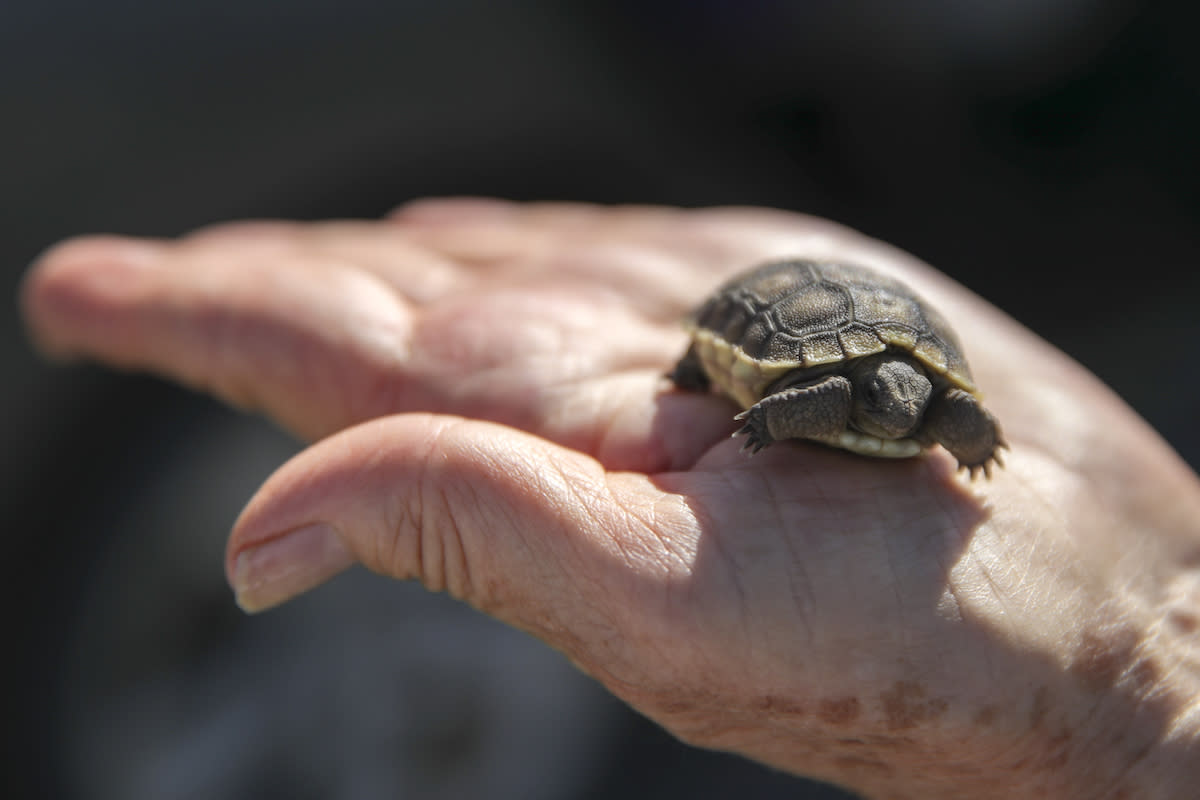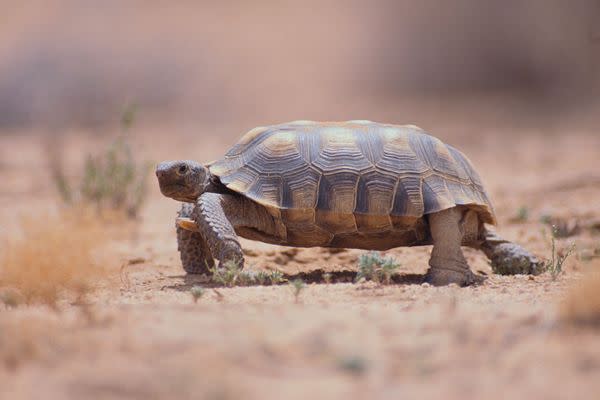California has officially listed the desert tortoise as endangered. Will it be enough to save them?

Native to northern Mexico and the southwestern United States, the desert tortoise (Gopherus agassizii) once roamed all over the vast Mojave and Sonoran deserts, marking the landscape with their distinctive dark brown and greenish-tan shells. Unfortunately for the species' long-term survival, human beings have been destroying their habitat in a number of ways, from paving new roads and operating military bases to constructing utility plants and grazing livestock.
The animals are also vulnerable to a range of deadly diseases such as upper respiratory illnesses and the shell disease cutaneous dyskeratosis, which softens their shells. Finally, as climate change worsens heat waves and intensified wildfires, desert tortoises suffer disproportionately.
Now the California Fish and Game Commission is officially recognizing what scientists and conservation experts have long asserted: The desert tortoise is an endangered species.
The desert tortoise had previously been classified as "threatened" by the California Endangered Species Act in 1989, as well as by the federal Endangered Species Act of 1990. The agency's new decision was made after four years of petitioning and advocacy from wildlife groups. It will expand the policy put into place more than thirty years ago, one that included a recovery plan establishing 10 designated tortoise conservation areas. In the subsequent three decades, the average the tortoise population has fallen by an average of 1% per year in locations like the Eastern Mojave and Colorado Desert recovery units. For the tortoise species to remain viable — an especially difficult feat, given their slow reproduction rates and long lifespans — an average of 3.9 adults must inhabit every square kilometer of those recovery areas.
At present, only two of the 10 regions meet that requirement.
If their population continues to decline at this precipitous rate, the desert tortoise will soon go extinct. That is why people like Kelly Herbinson, executive director of the Mojave Desert Land Trust (MDLT), agree with the recent decision to upgrade their conservation status from "threatened" to "endangered."
"Species like the desert tortoise play an important role in the health of the desert ecosystem," Herbinson said. "They are a keystone species, meaning if they were to be removed from the ecosystem, we would see a cascade of ecological effects — an unbalancing."
Once the desert tortoise is lost, it will be easier for invasive and highly flammable plant species to prevail and cause chaos, such as the red brome (Bromus madritensis) and cheatgrass (Bromus tectorum) that keep choking the desert to death. Wildfires could become more common, and the desert ecosystem overall may "even more wildly out of balance contributing to our ecosystems not functioning in a way that maintains human life," Herbinson said.

The desert tortoises also provide literal homes to countless animals that will suddenly be left exposed to the harshest elements of desert life. That's because these tortoises are also known as "ecosystem engineers" due to the ways in which they reshape the landscape.
"They are one of the few species in the desert that dig deep burrows into the soil," Herbinson said, adding that they do this to thermoregulate but often excavate more than they need. This allows other animals like birds, snakes, frogs, small rodents, lizards and many insects to move into those spaces.
Now, organizations like MDLT say it is humanity's turn to set aside spaces for the desert tortoise.
Want more health and science stories in your inbox? Subscribe to Salon's weekly newsletter Lab Notes.
"MDLT has made the protection of desert tortoises a priority in our conservation strategy," Herbinson said. "Many of our partners, including state and federal agencies and other NGOs are doing the same." The MDLT specifically is working with a large, multi-year grant to restore and protect a region inside a desert tortoise critical habitat with the goal of making sure it "remains an area tortoises can thrive." The organization is also working to purchase private land where desert tortoises live so that it too can be protected.
Other groups are joining the MDLT in trying to purchase more land to protect the desert tortoise, which is California's state reptile. One such group is the Desert Tortoise Preserve Committee, which was a co-petitioner in the original 2020 document that catalyzed the California Fish and Game Commission to make its recent decision.
“Our fifty years of experience at the Desert Tortoise Research Natural Area in the western Mojave desert showcases the effectiveness of protecting large tracts of contiguous land free of key threats such as off-highway vehicle use and livestock grazing,” said Roger Dale, president of the Desert Tortoise Preserve Committee. “We are hopeful that the uplisting will attract additional resources for proven conservation measures such as land acquisition, fencing, habitat restoration and permanent stewardship of preserve areas.”
Even if all of these conservation measures work, however, it will still take decades for the desert tortoise to have enough individuals to be entirely safe from threats to its survival. The primary reason for this is that the tortoises grow very slowly, often lay eggs only once or so a year and have eggs that take roughly 70 days to hatch. Unlike many other endangered species, it takes a lot of time for desert tortoises to replenish their populations even when outside conditions are ideal.
Yet they are far from ideal, which is why Herbinson has by her own admission spent "the better part of my 20+ year career as a desert tortoise field biologist." She recalled one occasion when she met eyes with a tortoise emerging from a burrow and found the experience "so magical it changed my life. I decided to dedicate my career to protecting them after that day."

